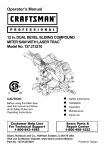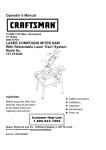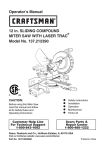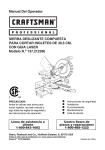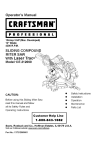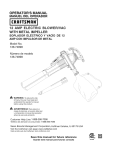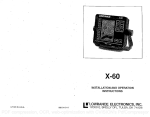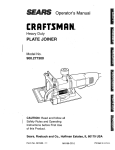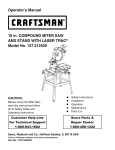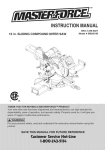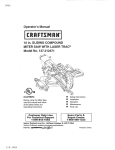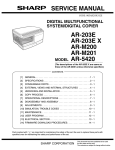Download Craftsman 137.212150 Operator`s manual
Transcript
Operator's Manual CRAFTSMAN 15 Amp - 3 HP (Max. Developed) 12" Blade 4000 R.P.M. LASER COMPOUND MITER SAW With Retractable Laser Trac® System Model 137.212150 \ \ Safety CAUTION: Instructions Installation Before using this Miter Saw, read this manual and follow Operation all its Safety Rules and Parts List Operating Maintenance Instructions Customer Help Line 1-800-843-1682 Sears, Roebuck and Co., Hoffman Estates, IL 60179 U.S.A. Visit our Craftsman website: www.sears.com/craftsman Part No. 137212150001 SECTION Warranty ........................................ Product Specifications ....................... Power Tool Safety ............................ Compound Miter Saw Safety ............... Electrical Requirements and Safety ...... Accessories and Attachments .............. Tools Needed For Assembly ................ Carton Contents .............................. PAGE 2 2 3 4 4-5 6 6 7 SECTION PAGE Know Your Compound Miter Saw ........ Glossary of Terms ............................ Assembly ....................................... Assembly & Adjustments ................... Operation ....................................... Maintenance ................................... 8 9 10 11 16 22 Troubleshooting Guide ....................... Parts List ......................................... 23 24 FULL ONE YEAR WARRANTY If this tool fails due to a defect in material or workmanship at its option repair or replace it free of charge. within one year of date of purchase, Return this tool to a Sears Service Center for repair, or to place of purchase Sears will for replacement. This warranty gives you specific legal rights, and you may also have other rights which may vary from state to state. Sears, Roebuck and Co., Dept. 817 WA, Hoffman Estates, IL 60179 Some dust created by power sanding, sawing, grinding, drilling and other construction activities contains chemicals known (to the State of California) to cause cancer, birth defects or other reproductive harm. Some examples of these chemicals are: • Lead from lead-based paints • Crystalline silica from bricks, cement and other masonry products • Arsenic and chromium from chemically treated lumber Your risk from these exposures varies, depending on how often you do this type of work. To reduce your exposure to these chemicals, work in a well ventilated area and work with approved safety equipment such as dust masks that are specially designed to filter out microscopic particles. MOTOR BLADE Power Source ......................... Horsepower ............................ Speed ..................................... Brake ..................................... Double Insulated ........................ Motor Arbor Shaft Size .............. 120 V AC, 60HZ, 15 Amp 3HP (Max. Developed) 4000 RPM (No load) Electric Yes 5/8" MITER SAW Cutting Capacity: Crosscut ............................ Miter 45 ° R.& L ................... Bevel 45 ° L ........................ 45 ° Miter and 45 ° Bevel ......... To avoid electrical hazards, 2-1/2" 2-1/2" 1-3/4" 1-3/4" fire hazards x 7-7/8" ; x 5-1/2" ; x 7-7/8"; x 5-1/2"; 3-7/8" 3-7/8" 2-3/4" 2-3/4" or damage x 5-7/8" x 4-1/8" x 5-7/8" x 4-1/8" SIZE Diameter .............................. Blade Arbor Size .................... Rotating 12" 1" w/a 5/8" Reducer Table: Diameter .............................. 13-1/2" Miter Detent Stops ..... 0, 15, 22.5, 31.6, 45 ° R&L ............. Bevel Positive Stops ............... Base Dimensions ................... 0, 33.9, 45° Left 23" x 16-3/4" Dust Bag ............................... Extension Wings .................... Sliding Fence ........................ Net Weight Yes Yes Yes 47 Ibs to the tool, use proper circuit protection. This tool is wired at the factory for 110-120 Volt operation. It must be connected to a 110-120 Volt / 15 Ampere time delay fuse or circuit breaker. To avoid shock or fire, replace power cord immediately if it is worn, cut or damaged in any way. Before using your tool, it is critical that you read and understand these safety rules. Failure to follow these rules could result in serious injury to you or damage to the tool. GENERAL SAFETY INSTRUCTIONS BEFORE USING THE MITER SAW Safety is a combination of common sense, staying and knowing how to use your miter saw. alert To avoid mistakes that could cause serious injury, do not plug the tool in until you have read and understood the following. . . READ and become familiar with the entire Operators Manual. LEARN the tool's application, limitations and possible hazards. KEEP GUARDS 3. REMOVE IN PLACE and in working ADJUSTING order. KEYS AND WRENCHES. Form the habit of checking to see that keys and adjusting wrenches are removed from the tool before turning ON. could cause permanent eye damage. ALWAYS wear Safety Goggles (not glasses) that comply with ANSI Safety standard Z87.1 Everyday eyeglasses have only impact-resistance lenses. They ARE NOT safety glasses. Safety Goggles are available at Sears. NOTE: Glasses or goggles not in compliance with ANSI Z87.1 could seriously injure you when they break. 13.WEAR A FACE MASK OR DUST MASK. Sawing operation produces dust. 14.SECURE WORK. Use clamps or a vise to hold work when practical. It's safer than using your hand and it frees both hands to operate tool. 15.DISCONNECT when changing cutters. 16.REDUCE . KEEP WORK AREA CLEAN. benches invite accidents. Cluttered areas and 5. DON'T USE IN DANGEROUS ENVIRONMENTS. Don't use power tools in damp locations, or expose them to rain or snow. Keep work area well lighted. 6. KEEP CHILDREN AWAY. All visitors and bystanders should be kept a safe distance from work area. 7. MAKE WORKSHOP CHILD PROOF with padlocks, master switches, or by removing starter keys. 8. DON'T FORCE THE TOOL. It will do the job better and safer at the rate for which it was designed. 9. USE THE RIGHT TOOL. Do not force the tool or an attachment to do a job for which it was not designed. 10.USE PROPER EXTENSION CORDS. Make sure your extension cord is in good condition. When using an extension cord, be sure to use one heavy enough to carry the current your product will draw. An undersized cord will result in a drop in line voltage and in loss of power which will cause the tool to overheat. The table on page 5 shows the correct size to use depending on cord length and nameplate ampere rating. If in doubt, use the next heavier gauge. The smaller the gauge number, the heavier the cord. 11.WEAR PROPER APPAREL. Do not wear loose clothing, gloves, neckties, rings, bracelets, or other jewelry which may get caught in moving parts. Nonslip footwear is recommended. Wear protective hair covering to contain long hair. 12.ALWAYS WEAR EYE PROTECTION. Any power tool can throw foreign objects into the eyes and TOOLS before the servicing, accessories such as blades, and bits and THE RISK OF UNINTENTIONAL STARTING. Make sure switch is in the OFF position before plugging the tool in. 17.USE RECOMMENDED ACCESSORIES. Consult this Operators Manual for recommended accessories. The use of improper accessories may cause risk of injury to yourself or others. 18.NEVER STAND ON THE TOOL. Serious injury could occur if the tool is tipped or if the cutting tool is unintentionally contacted. 19.CHECK FOR DAMAGED PARTS. Before further use of the tool, a guard or other part that is damaged should be carefully checked to determine that it will operate properly and perform its intended function check for alignment of moving parts, binding of moving parts, breakage of parts, mounting, and any other conditions that may affect its operation. A guard or other part that is damaged should be properly repaired or replaced. 20.NEVER LEAVE THE TOOL RUNNING UNATTENED. TURN THE POWER "OFF". Don't walk away from a running tool until the blade comes to a complete stop & unplug the unit. 21. DON'T OVERREACH. balance at all times. Keep proper footing and 22. MAINTAIN TOOLS WITH CARE. Keep tools sharp and clean for best and safest performance. Follow instructions for lubricating and changing accessories. 23.WARNING: Dust generated from certain materials can be hazardous to your health. Always operate saw in well-ventilated area and provide for proper dust removal. . USE ONLY CROSS-CUTTING SAW BLADES. When using carbide tipped blades, make sure they have a negative hook angle. IMPORTANT: DO NOT USE THIN KERF BLADES- they can deflect and contact guard and can cause possible injury to the operator. 2. DO NOT operate the miter saw until it is completely assembled and installed according to these instructions. IF YOU ARE NOT thoroughly familiar with the operation of miter saws, seek guidance from your supervisor, instructor, or other qualified person. . ALWAYS hold the work firmly against the fence and table. DO NOT perform any operation free hand (use clamp wherever possible). . KEEP HANDS out of the path of the saw blade. If the workpiece you are cutting would cause your hands to be within 8-1/2" inches of the saw blade, the workpiece should be clamped in place before making the cut. 6. BE SURE the blade is sharp, runs freely, and is free of vibration. 7. ALLOW the motor to come up to full speed before starting a cut. AIR SLOTS CLEAN 21.MAKE SURE the blade has come to a complete stop before removing or securing the workpiece, changing the workpiece angle, or changing the angle of the blade. 22. NEVER cut metals or masonry products with this tool. This miter saw is designed for use on wood and wood-like products. . 8. KEEP THE MOTOR 20. IMPORTANT: After completing the cut, release the power switch and wait for the blade to stop before returning the saw to the raised position. and free of 23.NEVER cut small pieces. If the workpiece being cut would cause your hand or fingers to be within 8-1/2" inches of the saw blade the workpiece is too small. 24.PROVIDE adequate support table for long work pieces. to the sides of the saw 25.NEVER use the miter saw in an area with flammable liquids or gases. 26.NEVER use solvents to clean plastic parts. Solvents could possibly dissolve or otherwise damage the material. 27.SHUT OFF the power before servicing the tool. or adjusting chips or dust. 9. ALWAYS MAKE SURE all handles are tight before cutting, even if the table is positioned in one of the positive stops. 10.BE SURE both the blade and the collar are clean and the arbor bolt is tightened securely. 11. USE only blade collars specified 13. NEVER apply lubricants running. in diameter to the blade when it is 14. ALWAYS check the blade for cracks or damage before operation. Replace a cracked or damaged blade immediately. 15. NEVER use blades recommended less than 4000 RPM. 16. USE the blade guards 17.ALWAYS 18.NEVER at all times. keep the blade guards reach around for operation in place. 29.MAKE SURE the work area is clean before the machine. leaving 30.SHOULD any part of your miter saw be missing, damaged, or fail in any way, or any electrical component fail to perform properly, shut off the switch and remove the plug from the power supply outlet. Replace missing, damaged, or failed parts before resuming operation. for your saw. 12. NEVER use blades larger or smaller than 12-inches. 28. DISCONNECT the saw from the power source and clean the machine when finished using. ELECTRICAL REQUIREMENTS POWER SUPPLY AND MOTOR at SPECIFICATIONS The AC motor used in this saw is a universal, nonreversible type. See "MOTOR" in the "PRODUCT SPECIFICATIONS" section on page 2. the saw blade. 19.MAKE SURE the blade is not contacting the workpiece before the switch is turned ON. To avoid electrical hazards, fire hazards, or damage to the tool, use proper circuit protection. Your saw is wired at the factory for 120V operation. Connect to a 120V, 15 Amp circuit and use a 15 amp. time delay fuse or circuit breaker. To avoid shock or fire, if power cord is worn or cut, or damaged in any way, have it replaced immediately. DOUBLEINSULATED[] Thepowertoolisdoubleinsulated toprovidea double thickness of insulation between youandtool'selectrical system. Allexposed metalpartsareisolatedfromthe internalmetalmotorcomponents withprotecting insulation. Replacement parts- Whenservicing useonlyidentical replacement parts. Polarizedplugs- Thissawhasa plugthatlookslikethe oneshownbelow: ,J ..... 4. FUSES may "blow" or circuit breakers may trip frequently if: a. MOTOR is overloaded - overloading can occur if you feed too rapidly or make too many start/stops in a short time. b. LINE VOLTAGE the nameplate voltage rating. For heavy loads, the voltage at motor terminals must equal the voltage specified on the nameplate. c. IMPROPER or dull saw blades are used. 5. Most motor troubles may be traced to loose or incorrect connections, overload, low voltage or inadequate power supply wiring. Always check the connections, the load and supply circuit if the motor doesn't run well. Check minimum gauge for the length of cord you are using on the chart below. GUIDELINES To reduce the risk of electrical shock, this saw has a polarized plug (one blade is wider than the other). This plug will fit in a polarized outlet only one way. If the plug does not fit fully in the outlet, reverse the plug. If it still does not fit, contact a qualified electrician to install the proper outlet. Do not change the plug in any way. Double insulation does not take the place of normal safety precautions when operating this tool. To avoid electrocution: 1. Use only identical replacement parts when servicing a tool with double insulation. Servicing should be performed by a qualified technician. 2. Do not use power tools in wet or damp locations or expose them to rain or snow. This tool is intended for indoor use only. MOTOR SAFETY PROTECTION IM PORTANT: To avoid motor damage, the motor should be blown out or vacuumed frequently to keep sawdust from interfering with the motor ventilation. 1. CONNECT this saw to a 120V, 15 amp. circuit with a 15 amp. time delay fuse or circuit breaker. Using the wrong size fuse can damage the motor. 2. If the motor won't start, release the trigger switch immediately. UNPLUG THE SAW. Check the saw blade to make sure it turns freely. If the blade is free, try to start the saw again. If the motor still does not start, refer to the "TROUBLESHOOTING GUIDE" 3. IF the tool suddenly stalls while cutting wood, release the trigger switch, unplug the tool, and free the blade from the wood. The saw may now be started and the cut finished. is more than 10% above or below FOR EXTENSION CORDS Use a proper extension cord. Make sure your extension cord is in good condition. When using an extension cord, be sure to use one heavy enough to carry the current your product will draw. An undersized cord will cause a drop in line voltage, resulting in loss of power and cause overheating. The table below shows the correct size to use depending on cord length and nameplate ampere rating. If in doubt, use the next heavier gauge. The smaller the gauge number, the heavier the cord. Be sure your extension cord is properly wired and in good condition. Always replace a damaged extension cord or have it repaired by a qualified person before using it. Protect your extension cords from sharp objects, excessive heat and damp or wet areas. Use a separate electrical circuit for your tools. This circuit must not be less than # 12 wire and should be protected with a 15 Amp time delay fuse. Before connecting the tool to the power line, make sure the switch is in the OFF position and the electric current is rated the same as the current stamped on the motor nameplate, running at a lower voltage will damage the motor. (When Ampere more than 0 6 10 12 Rating not more than 6 10 12 16 using 120 volts Total 25' 18 18 16 length 50' 16 16 16 14 12 only) of cord 100' 16 14 14 in feet 150' 14 12 12 not recommended CAUTION: In all cases make certain the receptacle in question is properly grounded. If you are not sure have a certified electrician, check the receptacle. RECOMMENDED • • • ACCESSORIES Use only accessories recommended for this miter saw. Follow instructions that accompany accessories. Use of improper accessories may cause hazards. The use of any cutting tool except 12 inch saw blades that meet the requirements under recommended accessories is prohibited. Do not use accessories such as shaper cutters or dado sets. Ferrous metal cutting, the use of abrasive wheels and the cutting of masonry products are prohibited. Do not attempt to modify this tool or create accessories not recommended for use with this tool. Any such alteration or modification is misuse and could result in a hazardous condition leading to possible serious injury. ACCESSORIES Visit your Sears Hardware Department or see the Sears Power and Hand Tool Catalog to purchase recommended accessories for this power tool. To avoid the risk of personal injury, do not modify this power tool or use accessories not recommended by Sears. Read warnings and conditions on your CARBIDE TIPPED SAW BLADE. Do not operate the saw without the proper saw blade guard in place. Carbide is a very hard but brittle material. Care should be taken while mounting, using, and storing carbide tipped blades to prevent accidental damage. Slight shocks, such as striking the tip while handling, can seriously damage the blade. Foreign objects in the workpiece, such as wire or nails, can also cause tips to crack or break off. Before using, always visually examine the blade and tips for bent teeth, cracks, breakage, missing or loose tips, or other damage. Do not use if damage is suspected. Failure to heed safety instructions and warnings can result in serious bodily injury. Phillips scre_river UNPACKING YOUR . MITER SAW items are accounted packing material. To avoid injury from unexpected starting or electrical shock, do not plug the power cord into a source of power during unpacking and assembly. This cord must remain unplugged whenever you are working on the saw. 1. Remove 2. Do not lift the miter saw by the switch handle or miter table handle. It may cause misalignment. Always lift the machine by the built in carry handle. Place the saw on a secure stationary work surface. the miter saw from the carton. Separate all parts from the packing material. Check each one with the illustration to make certain all for, before discarding any If any part is missing or damaged, do not attempt to assemble the miter saw, or plug in the power cord until the missing or damaged part is correctly replaced. To avoid electric shock, use only identical replacement parts when servicing double insulated tools. IMPORTANT: Blade Wrench (Stored behind carry handle) Dust Collector Elbow Hold-down Clamp Dust Bag Miter Saw _ Lock Knobs Lock Knobs o e o o Flat Washers -- Left & Right Extension Wings Arm Brackets 7 Extension Wing Screws ON / OFF Trigger Safety Lock-OFF Switch Button Power Cord Storage Clips Cutting Head Handle Upper Blade Guard Handle Locking Lever Laser guide Arbor Lock Motor Saw Blade Lower Blade Guard Dust Bag Bevel Scale Sliding Fence Extension Hold Down Clamp Left Extension ig Fence Arm Bracket o Base / Bevel Lock Handle Table Mounting Positive Stop Locking Lever Miter Handle Quick-Cam Miter Lock Handle 8 Holes Right Extension Wing trigger switch and a safety lock-off CRAFTSMAN TERMS COMPOUND MITER ARBOR LOCK - Allows the user to keep the blade from rotating while tightening or loosening the arbor locking bolt during blade replacement or removal. BASE - Supports the table, holds accessories for workbench or leg set mounting. and allows BEVEL LOCKING HANDLE - Locks the miter saw at a desired bevel angle. BEVEL SCALE - To measure blade 0 ° to 45 ° left. COVER PLATE SCREW the plate for access DUST CHUTE EXTENSION - WING this screw ARBOR debris away from the user. the width of the work table FENCE - Helps to keep the workpiece from moving sawing. Scaled to assist with accurate cutting. LOCK-OFF BUTTON must be pushed forward - Yellow to activate when button on handle the trigger switch. LOWER BLADE GUARD - Helps protect your hands from the blade in the raised position, it retracts as the blade is lowered. MITER HANDLE - Used left cutting position. to rotate the saw to the right or MITER SCALE - To measure the miter angle 0 ° to 45 ° left, 0° to 45 ° right. MOUNTING surface. HOLES WRENCH misplacing STORAGE - Convenient the blade wrench. storage to prevent TERMS and rotate bolt. for support while cutting long work pieces. They can be used with or without a stop block as an additional side fence. SAFETY WARNING LABELS - Read and understand for your own safety. Always make certain these are in place & legible. WOODWORKING Loosen - Extends blade is lowered into the workpiece by pushing down on the handle. The saw will return to its upright position when the handle is released. the bevel angle of the saw to the blade arbor locking - Exhausts slide switch. The SAW - The shaft on which a blade is mounted. BEVEL CUT - An angle cut made through the face of the workpiece. COMPOUND CUT- A simultaneous bevel and miter cut. CROSS CUT - A cut made across the width or grain of the workpiece. FREEHAND - Performing a cut without using a fence (guide), hold down or other proper device to prevent the workpiece from twisting during the cutting operation. GUM -A sticky sap from wood products. HEEL - Misalignment KERF - The amount of the blade. of material removed by blade cut. MITER CUT - An angle cut made across the width or grain of the workpiece. RESIN -A sticky sap that has hardened. - To mount the miter saw to a stable REVOLUTIONS turns completed PER MINUTE (RPM) - The number by a spinning object in one minute. of ON/OFF TRIGGER SWITCH - To prevent the trigger from being accidentally engaged, a lock-off slide switch is provided. To start the tool, push the lock-off slide switch forward and squeeze the trigger. Release the trigger to stop the miter saw. SAW BLADE PATH - The area of the workpiece or table top directly in line with the travel of the blade or the part of the workpiece which will be cut. POSITIVE SET - The distance between two saw blade tips, bent outward in opposite directions to each other. The further apart the tips are, the greater the set. STOP LOCKING LEVER- Used in combination with the miter handle, it locks the miter positive stop for the desired miter angle. STOP LATCH - Locks the miter saw saw at a preset in the lowered position for compact storage and transportation. SWITCH HANDLE - The cutting head handle contains the WORKPIECE - The item being cut. The surfaces of a workpiece are commonly referred to as faces, ends, and edges. ASSEMBLY INSTRUCTIONS Fig. B To avoid injury, do not connect this miter saw to the power source until it is completely assembled and adjusted, and you have read and understood this Operators Manual. INSTALLING EXTENSION WINGS & ARM BRACKETS (FIG. A) 1. Slide the extension wing (1) into the mounting holes (2) of the saw base. 2. Thread the locking screw (3) into the extension wing then tighten with a Phillips screwdriver. 3. Place one flat washer (4) onto one lock knob (5), insert through the arm bracket (6) and thread into the extension wing. Repeat for second lock knob. 4. Thread the extension wing lock knob (7) into the threaded hole in the base (8) to lock the extension wing into place. 5. Repeat steps 1 through 4 for right side extension. INSTALLING THE DUST BAG (Fig. C) 1. Squeeze the metal collar wings (1) of the dust bag (2). 1. Place the dust bag neck opening around the exhaust port (3), and release the metal collar wings. Fig. C NOTE: The arm brackets serve two purposes: To act as a stop block for repetitive cuts and to level the workpiece when the extension wings are fully extended for additional work support (see Operation for details). Fig. A 7 J INSTALLING THE HOLD-DOWN CLAMP (Fig. D) 1. Loosen two lock knobs (1) in each side on the rear of the saw base (2). . Place the Hold-down Clamp (3) on either the left or right mounting hole (4). 3. Tighten the lock knob to secure the clamp in place. \ 4 3 Fig. D 4 6 1 5 INSTALLING THE DUST COLLECTION ELBOW (Fig. B) 1. Install the larger end of the elbow (1) onto the exhaust port (2). NOTE: The elbow can be used to attach either the dust bag or a vacuum work area. hose to remove sawdust from the © RAISING THE CUTTING HEAD (Fig. E) Raising 1. Push down slightly on the cutting handle. 2. Pull out the stop latch (1). 3. Allow the cutting head to rise to the up position. REMOVING To avoid injury store the miter down position. cutting head in REMOVING and damage to the saw, transport or saw with the cutting head locked in the Never use the stop latch to hold the a down position for cutting operations. Fig. E 1. 2. OR INSTALLATING THE BLADE Only use a 12-inch diameter blade. To avoid injury from an accidental start, make sure the switch is in the OFF position and plug is not connected to the power source outlet. (Fig. G, H, I) 1. Unplug the saw from the outlet. 2. Raise the miter saw to the upright position. 3. Loosen the cover plate screw (2) with a Phillips screwdriver. 4. Rotate the cover plate (3) to expose the arbor bolt (4). 5. Place the blade end wrench over the arbor bolt. Fig. G 3 \ LOCKING 1. Push the cutting head down to its lowest position. 2. Push the stop latch (1) into the locking hole. IMPORTANT: To avoid damage, never carry the miter saw by the switch handle, the cutting arm, or the miter table handle. ALWAYS use the designated carrying handle located on the top of the machine. BLADE WRENCH STORAGE (Fig. F) For convenient storage and prevention of loss, there is a slot (1) located in the rear of the carry handle for storing the blade wrench (2). 6. Locate the arbor lock (5) on the motor, below the miter saw switch handle. (Fig. H) 7. Press the arbor lock, holding it in firmly while turning the blade wrench clockwise. The arbor lock will then engage and lock the arbor. Continue to hold the arbor lock while turning the wrench clockwise to loosen the arbor bolt. Fig. F IMPORTANT: Fig. H 5 REMOVING - cont'd 8. Remove the arbor bolt (4), the outer blade collar (6), and the blade (7) with the 5/8" reducer. Do not remove the inner blade collar. (Fig. I) 9. Raise the lower clear plastic blade guard (1) to the upright position (Fig. G) to remove the blade. NOTE: Pay attention to the pieces removed, noting their position and direction they face. Wipe the blade collars clean of any sawdust before installing a new blade. Also, the 12" blade has a 1" arbor hole with a 5/8" reducer to mount onto the saw. Fig. I 4 To avoid injury from an accidental start, make sure the switch is in the OFF position and the plug is not connected to the power source outlet. To avoid injury, never use the saw without the cover plate secure in place. It keeps the arbor bolt from falling out if it accidentally loosens, and helps prevent the spinning blade from coming off the saw. ADJUSTING FENCE SQUARENESS (Fig. J) 1. Set the bevel and miter angles at zero degrees. 2. Lower and lock the cutting head into position. 3. Using a square, lay the heel of the square against the blade, and the rule against the fence (2) as shown. NOTE: Be sure to rest the square against the body of the blade and not against the teeth of the blade. 4. If the blade is not 90 ° to the fence, loosen the three fence locking bolts (1). 5. Adjust the fence 90 ° to the blade and re-tighten the three fence locking bolts. CAUTION: If the saw has not been used recently, recheck blade squareness to the fence and readjust needed. 6 7 Fig. J INSTALLING Un-plug blade. 1. Install a 5/6" blade Make sure the flats of the blade collars are engaged with the flats on the arbor shaft. Also, the flat side of the arbor collar must be placed against the blade. 3. Place the blade wrench on the arbor bolt. 4. Press the arbor lock (5), holding it in firmly while turning the blade wrench counterclockwise. When the arbor lock engages, continue to press the arbor lock in while tightening the arbor bolt securely. (Fig. H) 5. Rotate the cover plate (3) back to its original position until the slot in the cover plate engages with the cover plate screw (2). Tighten the screw with a Phillips screwdriver. (Fig. G) 6. Be sure the arbor lock is released so the blade turns freely by spinning the blade until the arbor lock disengages. BLADE the miter saw (Fig. before G, H, I) changing/installing the a 12" blade with a 5/8" arbor (or a 1" arbor with reducer) making sure the rotation arrow on the matches the clockwise rotation arrow on the upper guard, downward. and the blade teeth are pointing 2. Place the outer blade collar (6) against the blade and on the arbor. Thread the arbor bolt (4) on the arbor (Fig. I} in a counterclockwise direction. if MITER SCALE (Fig, K) The miter saw table has nine of the most common angle settings with positive stops at 0°, 15 °, 22.5 °, 31.6 ° and 45 °. These positive stops position the blade at the desired angle quickly and accurately. , 4. Miter Angle Pointer Adjustment (Fig. K): 1. Place the miter table at the zero position making sure the positive stop locking lever snaps into position. 2. Loosen the miter angle indicator screw (1) and adjust the indicator to the "0" mark on the miter scale. 3. Tighten miter angle indicator screw. (1), grasp the miter handle (2) and move the miter table left or right to the desired angle. Release the positive stop locking lever. Press down on the Miter Quick-Cam locking lever (3) until it locks the miter table in place. NOTE: The miter Quick-Cam locking lever should lock the table and prevent it from moving left or right. If adjustment is needed, see next step. Miter Quick-Cam Table Lock Adjustment: (Fig. M) Note: Fig. M is a view from underneath the saw 1. Press down and lock the miter quick-cam table lock (1). 2. Turn the stop nut (2) to the left as shown using a 13mm wrench to extend the locking arm against the base of the miter saw. Fig. K 3. 4. Test the quick cam miter lock to verify it locks the table into position securely. Turn the lock nut (3) to the right as shown to lock the miter locking mechanism into place. Fig. M Positive Stop Miter Angle Adjustment: (Fig. L) 1. Unlock the miter table by lifting up on the miter quick-cam table lock (3). 2. While holding the positive stop locking lever down (1), grasp the miter handle (2) and move the miter table left or right to the desired angle. 3. Release the positive stop locking lever and set the miter at the desired angle making sure the lever snaps into place. NOTE: The lever will only lock into place at one of the nine positive stops. To lock the table at all other degrees, see next section. 90 o BEVEL 1 STOP ADJUSTMENT (Fig. N) To avoid injury from unexpected starting or electrical shock, turn the switch OFF and remove the power cord from the power source. 90 ° Bevel adjustment (Fig. N) 1. Loosen the bevel lock handle (1) by rotating it clockwise and tilt the cutting arm completely to the right. Tighten the bevel lock handle. 2. Place a combination square (2) on the miter table with the rule against the table and the heel of the square against the saw blade. 3. If the blade is not 90 ° square with the miter table, loosen the bevel lock handle, remove the cover plate (4), turn the bevel angle adjusting screw (3) in or out with a 2.5mm hex wrench until the blade is Fig. L 2 1 4. 3 Quick-Cam Miter Table Lock Operation: (Fig. L) If miter angles required are NOT one of the nine positive stops noted above, the miter table can be locked at any angle between these positive stops by using the Miter Quick-Cam table lock. 1. Unlock the miter table by lifting up on the miter quick-cam table lock (3). 2. While holding the positive stop locking lever down 5. 6. ]3 square with the table. Repeat steps 1 & 2 to verify blade squareness and replace the cover plate once alignment is achieved. When the blade is exactly 90 ° to the table loosen the left bevel indicator screw (5) using Phillips screwdriver. Adjust the bevel indicator bevel scale and retighten (6) to the "0" mark on the the screw. 33.9 ° Bevel Adjustment (Fig. O) 1. Push the bevel detent pin (9) in toward the front of the unit. Fig. N 2. 3. 4. Unlock the bevel lock handle and tilt the cutting arm to the crown molding positive stop at 33.9 o Using a combination square, check to see if the blade angle is 33.9 ° to the table. If the blade is not at 33.9 ° to the miter table, loosen Iocknut (7) then turn the bevel angle adjusting bolt (8) in or out with a 10mm wrench until the blade is at 33.9 ° to the miter table. 5. Secure the locking nut (7) into position alignment is achieved. BEVEL SCALE There are two bevel scales viewing 1 3 45 ° Bevel adjustment (Fig. O) 1. Unlock the bevel lock handle and tilt the cutting arm as far to the left as possible making sure the crown molding positive stop pin (9) is pulled out towards the rear of the machine. 2. Using a combination square, check to see if the blade angle is 45 ° to the table. 3. If the blade is not at 45 ° to the miter table, loosen the bevel locking lever, turn the bevel adjustment screw (10) in or out with a 2.5mm hex wrench until the blade is 45 ° to the miter table. 4. Repeat steps 1 & 2 to verify blade squareness. 5. When the blade is exactly 45 ° to the table, loosen the RIGHT bevel indicator screw using Phillips screwd river. 6. Adjust the bevel indicator to the 45 ° mark on the bevel scale and retighten the screw. Fig. 0 5 10 at all bevel angles. on this machine after for ease in ALIGNING THE LASER GUIDE (Fig. P, Q, R) This adjustment was made at the factory however minor adjustment may be required before the tool is used for the first time. Also, the laser alignment should be checked periodically to verify accuracy. You also have the option to change the laser projection to the left, middle or right side of the blade according to your preference when using the laser to guide the cutting operation. When using the laser on an edge of the workpiece, it may require recalibration to cut at the left or right of the kerf. Fig. Q Laser-beam For your own safety, never connect the plug to power source outlet until all the adjustment steps are complete and you have read and understood the safety and operational instructions. How to Check Laser-beam 1. 2. 3. Laser Position J Adjustment If the Laser Beam moves when the upper cutting arm is raised and lowered, adjust the screw (3) cautiously with a slotted screwdriver +/- 5 ° or approximately 1/8 turn. Alignment Find a 90 ° square scrap workpiece and scribe a 90 ° line as the calibrating pattern and position the workpiece on the table. Turn on the laser and line up the laser beam with the scribed line. 5 Fig. R Lower the cutting head to verify the blade is parallel to the side of the scribed line. Parallel Laser Beam Adjustment (Fig. P) Lower the cutting head so the blade is flush with the side of the scribed line. Turn on the laser beam, loosen the screw (4 - Fig. R) ¼ turn and adjust the thumbscrew (2 - Fig. R) accordingly then retighten the screw (4). Fig. P . I w m m u m m m n m m m i CHANGING THE BATTERIES (Fig. R) m m m m i m w Unplug your miter saw before making any adjustments. Failure to unplug your saw could result in accidental starting causing possible serious personal injury. m m u i m m i Laser- beam Laser Beam Angle Adjustment (Fig. Q) If the laser-beam is not parallel to the scribed line, adjust the screw (1 - Fig. R) with a Phillips screwdriver. Be careful not to overturn the adjustment screw. The maximum turn for the screw (1 - Fig. R) is +/- 5or approximately 1/8 turn to prevent any possible wire damage. 1. Lift open the battery cover (5). 2. Remove and replace the two batteries. Note: Replace the batteries that have a rating of 1.5 volts (Number 4 series and AAA size or equivalent). When replacing the batteries, the battery cover should be thoroughly cleaned. Use a soft paintbrush or similar device, to remove all sawdust and debris. SAFETY INSTRUCTIONS OPERATION FOR BASIC SAW Replace damaged, missing, or defective parts before using the saw again. Maintain tools with care. Keep the miter saw clean for best and safest performance. Follow instructions for lubricating. Don't put lubricants on the blade while it's spinning. BEFORE USING THE MITER SAW To avoid mistakes that could cause serious, permanent injury, do not plug the tool in until the following steps are completed: • Completely assemble and adjust the saw, following the instructions. (ASSEMBLY AND ADJUSTMENTS) • Learn the use and function of the ON/OFF switch, lock-off switch, upper and lower blade guards, stop latch, bevel lock handle, and cover plate screws. • Review and understand all safety instructions and operating procedures in this Operator's Manual. (SAFETY & OPERATIONS) • Review the MAINTENANCE and TROUBLESHOOTING GUIDE for your miter saw. • To avoid injury or possible death from electrical shock: Make sure your fingers do not touch the plug's metal prongs when plugging or unplugging your miter saw. (ELECTRICAL REQUIREMENTS AND SAFETY) BEFORE EACH USE Inspect your saw. • Disconnect the miter saw. To avoid injury from accidental starting, unplug the saw before any adjustments, including set-up and blade changes. • Compare the direction of rotation arrow on the guard to the direction arrow on the blade. The blade teeth should always point downward at the front of the saw. • Tighten the arbor bolt. • Tighten the cover plate screw. • Check for damaged parts. Check for: • Alignment of moving parts • Damaged electric cords • Binding of moving parts • Mounting holes • Function of arm return spring and lower guard: Push the cutting arm all the way down, then let it rise until it stops. The lower guard should fully close. Follow instructions in TROUBLESHOOTING GUIDE for • • adjustment. Other conditions that may affect the way the miter saw works. Remove all adjusting wrenches from the tool before turning it on. USE ONLY RECOMMENDED ACCESSORIES Consult the ACCESSORIES and ATTACHMENTS section of this Operators Manual for recommended accessories. Follow the instructions that come with the accessory. The use of improper accessories may cause risk of injury to persons. • Choose the correct 12 inches diameter blade for the material and the type of cutting you plan to do. Do not use Thin Kerf blades, • Make sure the blade is sharp, undamaged and properly aligned. • Make sure the blade and arbor collars are clean. • Make sure all clamps and locks are tight and there is no excessive play in any parts. KEEP YOUR WORK AREA CLEAN Cluttered areas and benches invite accidents. To avoid burns or other fire damage, never use the miter saw near flammable liquids, vapors, or gases. • Plan ahead to protect your eyes, hands, face and ears. • Know your miter saw. Read and understand the Operator's Manual and labels affixed to the tool. Learn its application and limitations as well as the specific potential hazards peculiar to this tool. To avoid injury from accidental contact with moving parts, don't do layout, assembly, or setup work on the miter saw. • Avoid accidental starting Make sure the switch is OFF before plugging the miter saw into a power outlet. Keep all guards in place, in working order and proper adjustment. If any part of this miter saw is missing, bent damaged or broken in any way, or any electrical parts don't work, turn the saw off and unplug it. 16 PLAN YOUR WORK • Use the right tool. Don't force a tool or attachment to do a job it was not designed to do. Use a different tool for any workpiece that can't be held in a solidly braced, fixed position. CAUTION: This machine is NOT designed for cutting masonry, masonry products & ferrous metals (steel, iron, and iron-based metals.) Use this miter saw to cut only wood, wood-like products, or soft metals like aluminum. Other material may shatter, bind the blade, or create other dangers. Remove all nails that may be in the workpiece to prevent sparking that could cause a fire. • • • USE EXTRA CAUTION WITH LARGE OR ODD SHAPED WORKPIECES. • • DRESS FOR SAFETY Any power tool can throw foreign objects into the eyes. This can result in permanent eye damage. Everyday eyeglasses have only impact resistant lenses and are not safety glasses. Glasses or goggles not in compliance with ANSI Z87.1 could seriously injure you when they break. • Do not wear loose clothing, gloves, neckties or jewelry (rings, watches). They can get caught and draw you into moving parts. • Wear non-slip footwear. • Tie back long hair. • Roll long sleeves above the elbow. • Noise levels vary widely. To avoid possible hearing damage, wear ear plugs when using any miter • For dusty operations, safety goggles. When cutting odd shaped workpieces, plan your work so it will not bind in the blade and cause possible injury. Molding, for example, must lie flat or be held by a fixture or jig that will not let it move when cut. • Properly support round material such as dowel rods, or tubing, which have a tendency to roll when cut, causing the blade to "bite". wear a dust mask along with INSPECT YOUR WORKPIECE Make sure there are no nails or foreign objects in the part of the workpiece being cut. Plan your work to avoid small pieces that may bind, or that are too small to clamp and get a solid grasp on, Plan the way you will grasp the workpiece from start to finish. Avoid awkward operations and hand positions. A sudden slip could cause your fingers or hand to move into the blade. Use extra supports (tables, sawhorses, blocks, etc.) for workpieces large enough to tip. Never use another person as a substitute for a table extension, or as an additional support for a workpiece that is longer or wider than the basic miter saw table, or to help feed, support, or pull the workpiece. Do not use this saw to cut small pieces. If the workpiece being cut would cause your hand or fingers to be within 8-1/2" inches of the saw blade workpiece is too small. Keep hands and fingers out of the "no hands zone" area marked on the saws table. • saw. • Make sure there are no gaps between the workpiece, fence and table that will let the workpiece shift during the cut. Keep the cut off piece free to move sideways after it is cut off. Otherwise, it could get wedged against the blade and thrown, possibly causing injury. Only the workpiece should be on the saw table. Secure work. Use clamps or a vise to help hold the work when it's practical. To avoid injury, follow all applicable safety instructions, when cutting non-ferrous metals: • Use only saw blades specifically recommended for non-ferrous metal cutting. • Do not cut metal workpieces that must be hand held. Clamp workpieces securely. • Cut non-ferrous metals only if you are under the supervision of an experienced person. WHEN SAW IS RUNNING DON'T OVER-REACH Don't allow familiarity from frequent saw to result in a careless mistake. Keep good footing and balance. Keep your face and body to one side, out of the line of a possible kickback. NEVER stand in the line of the blade. of a second Never cut freehand: • • Brace your workpiece firmly against the fence and table stop so it will not rock or twist during the cut. Make sure there is no debris between the workpiece and the table or fence. is enough use of your miter A careless fraction to cause a severe injury. Before cutting, if the saw makes an unfamiliar noise or vibrates, stop immediately. Turn the saw OFF. Unplug the saw. Do not restart until finding and correcting the problem. 17 BODY AND HAND POSITION (Fig. S) Proper positioning of your body and hands when operating the miter saw will make cutting easier and safer. Never place hands near the cutting area. Place hand at least 8-1/2" away from the path of the blade. Hold workpiece firmly against the fence to prevent movement toward the blade. Keep hands in position until the trigger has been released and the blade has completely stopped. Before making a cut, with the power switch in the OFF position bring the saw blade down to the workpiece to see the cutting path of the blade. • Keep children away. Keep all visitors a safe distance from the miter saw. Make sure bystanders are clear of the miter saw and workpiece. • Don't force the tool. It will do the job better and safer at its designed rate. Feed the saw into the workpiece slowly with a firm downward motion. • • • • • • Before freeing jammed material Turn switch OFF. Unplug the miter saw. Wait for all moving parts to stop. After finishing a cut Keep holding the power head down. Release the switch, and wait for all moving parts to stop before moving your hands. If the blade doesn't stop within 6 seconds, unplug the saw and follow refer to THE TROUBLESHOOTING GUIDE. THREE POSITION ROTATING HANDLE (Fig. U) The handle of the miter saw has been designed to rotate and lock at three different positive stops; 0°, 45 °, and 90 ° for operator convenience. To rotate the handle: 1. Unlock the red handle locking lever (4) by pulling it toward the front of the machine. 2. Pull the red handle-locking latch (8) to the front of the saw and hold in position. 3. Rotate the handle to 0°, 45 ° or 90 ° and release the handle locking latch. NOTE: After releasing the handle locking latch, rotate the handle left and right to make sure the latch engages into the positive locking position. 4. Lock the handle locking lever (4) by pushing it IN toward the rear of the handle. NOTE: The tightness of the rotating handle (1)when locked in position can be adjusted by following steps: 1. Loosen & remove the four screws (6), and remove the carry handle (7). 2. If the rotating handle (1) is too loose or tight, adjust the nut (9) clockwise or counter clockwise with a 13mm wrench. Fig. U 7 Fig. S 8 4 3 8-1/2" 8-1/2" LASER ON/OFF SWITCH (Fig. T) Laser radiation. Avoid direct eye exposure. Always un-plug miter saw from power source before making any adjustment. 1. Unlock the laser guide lever (1) by pulling it out toward the left side of the saw. 2. Slide out on the laser guide assembly by pulling on the tab (2) 3. Lock the laser guide assembly into place by pushing the locking lever in toward the right side of the saw. 4. To turn the laser ON or OFF, press the rocker switch (3). TURNING THE SAW ON (Fig. U) To reduce the likelihood of accidental starting, a thumb activated yellow lock-OFF switch is located on top of the switch handle. The safety lock-OFF button (2) must be pushed forward before the trigger switch can be activated and the miter saw started. Make the switch child-proof. Insert a padlock through the hole (3) in the trigger switch and lock it. This will prevent children and other unauthorized users from turning the switch ON. SLIDING FENCE (Fig. V) BEVEL CUT (Fig. X) The sliding fence must be fully extended to the left when making any compound or bevel cuts. Failure to fully extend the sliding fence will not allow enough space for the blade to pass through, which could result in serious injury. 1. Unlock the fence cam locking lever (1) by pushing it toward the rear of the machine. 2. Fully extend the fence (2) by sliding it out as far as possible. 3. Lock the fence cam lock by pushing it IN toward the fence. NOTE: When transporting the saw, always secure the sliding fence in the collapsed position (toward the saw blade). Fig. V The sliding fence must be fully extended to the left when making any bevel cuts. Failure to fully extend the sliding fence will not allow enough space for the blade to pass through, which could result in serious injury. Failure to extend the fence may cause the saw blade to make contact with the fence. 1. When a bevel cut is required, loosen the bevel lock handle (1) by turning it clockwise. Tilt the cutting head to the desired angle as shown on the bevel scale (2). The blade can be positioned at any angle, from a 90 ° straight cut (0 ° on the scale) to a 45 ° left bevel. Tighten the lock handle (1)to lock the cutting head in position. Positive stops are provided at 0 °, 33.9 ° and 45 °. Fig. X 1 2 MITER CUT (Fig. W) 1. Unlock the miter quick-cam table lock (3) and press and hold down the positive stop locking lever (1). 2. While holding the positive stop locking lever down, grasp the miter handle (2) and move the miter table left or right to the desired angle. 3. Release the positive stop locking lever, making sure it engages the positive stop. Slight movement of the miter handle left or right will ensure positive stop engagement. NOTE: Positive stops at provided at 0°, 15 °, 22.5 °, 31.6 ° and 45 ° right and left. NOTE: If the miter angle required is NOT one of the positive stops noted above, the miter table can be locked at any angle between these positive stops by using the miter quick-cam table lock. Fig. W NOTE: The saw comes with a 33.9 ° bevel detent pin for setting up crown molding cuts. 33.9 ° BEVEL DETENT PIN FOR CROWN MOLDINGS (Fig. Y) 1. 2. 3. 4. Push the crown molding stop pin (1) in toward the front of the machine. Loosen the bevel lock handle. Rotate the cutting head until the crown molding stop pin stops the bevel angle at 33.9 ° on the bevel scale. Tighten the bevel lock handle before you make your cut. Fig. Y \ 1 3 2 COMPOUND CUT (Fig. Z) The sliding fence must be fully extended to the left when making any compound cuts. Failure to fully extend the sliding fence will not allow enough space for the blade which could result in serious injury. 1. 2. 3. Fig. BB Fully extend the fence by sliding it out as far as possible. See "SLIDING FENCE". Set the desired bevel angle and lock into position with the bevel lock handle (1). Set the desired miter angle using positive stop the locking lever (3) or the miter quick lock (2). Fig. Z NOTE: When mounted saw table is 3-7/8" high. CUTTING BOWED MATERIAL (Fig. AA) A bowed workpiece must be positioned properly before cutting. Do not position workpiece incorrectly or try to cut the workpiece without the support of the fence. This will cause the blade to bind and could result in personal injury. on a flat surface, the miter When making multiple or repetitive cuts that result in cut-off pieces of one inch or less, it is possible for the saw blade to catch the cut-off piece and throw it out of the saw or into the blade guard and housing, possibly causing damage or injury. To minimize this risk, turn off the machine, wait until the blade comes to a complete stop, unplug the unit & remove the cut pieces. Fig. AA AUXILARY WOOD FENCE (Fig. CC) Holes are provided in the saw fence to attach an auxiliary wood fence (this provides additional depth of cut). This fence should be constructed of straight auxiliary wood approximately 3/4 inch thick by 2-1/2 inches high by 21 inches long. Attach the wood fence securely and make a full depth cut to make a blade slot. Check for interference between the wood fence and the lower blade guard. Adjust Fig. CC Blade slot WORKPIECE SUPPORT (Fig. BB) Long pieces need extra support. The support should be placed under the workpiece. Keep your hand holding the workpiece positioned 8-1/2" or more away from the blade. The support must let the workpiece lay flat on the work table during the cutting operation. NOTE: When mounted on a flat surface, the miter saw table is 3-13/16 inches high. if necessary. CUTTING BASEMOLDING (Fig.DD) Basemoldings andmanyothermoldings canbecuton acompound mitersaw.Thesetupofthesawdepends onmoldingcharacteristics andapplication, asshown. Performpracticecutsonscrapmaterialtoachievebest results: 1.Alwaysmakesuremoldings restfirmlyagainstfence andtable.Usehold-down, crownmolding viseor C-clamps, whenever possible, andplacetapeonthe areabeingclampedtoavoidmarks. 2.Reducesplintering bytapingthecutareapriorto makingthecut.Markthecutlinedirectlyonthetape. 3.Splintering typicallyhappens dueto anincorrect bladeapplication andthinnessofthematerial. Fig. EE Miter saw table Fig. DD Fig. FF F Settings for standard crown compound miter saw table mo_ding _nside corner OR tying flat on ] Miter saw table Miter at 45 °, bevel i] at 0 _ Miter at 0 °, bevel at 45 ° Outside NOTE: Always perform a dry run cut so you can determine if the operation being attempted is possible before power is applied to the saw. CUTTING CROWN MOLDING (FIG. EE, FF) Your compound miter saw is suited for the difficult task of cutting crown molding. To fit properly, crown molding must be compound-mitered with extreme accuracy. The two surfaces on a piece of crown molding that fit flat against the ceiling and wall are at angles that, when added together, equal exactly 90 ° . Compound cut crown In order to accurately cut crown molding for a 90 ° inside or outside corner, lay the molding with its broad back surface flat on the saw table. When setting the bevel and miter angles for compound miters, remember that the settings are interdependent; changing one changes the other, as well. Also keep in mind that the angles from crown molding are very easy for these angles to shift slightly, all settings should be tested on scrap molding. KEY BEVEL MITER SETT NG SETT NG IL 33.9 ° TYPE OF CUT possible, and to avoid marks. corner-Left side 31.6 ° 1. Position top of molding Right fence. 2. Miter table set at RIGHT 3. LEFT side is finished Inside IR 33.9 ° 31.6 ° Left corner-Right against 31.6 °. piece. side 1 .Position bottom of molding against fence. 2.Miter table set at LEFT 31.6 °. 3.LEFT side is finished piece. Outside corner-Left side OL OR Use a safety clamping vise, whenever place tape on the area being clamped moldings Bevel/Miter Settings Inside Most crown molding has a top rear angle (the section that fits flat against the ceiling) of 52°and a bottom rear angle (the section that fits flat against the wall) of 38 ° . corner 33.9 ° 33.9 ° 31.6 ° Left 31.6 ° Right 1 .Position bottom of molding against fence. 2.Miter table set at LEFT 31.6 °. 3.RIGHT side is finished piece. Outside corner-Right side 1.Position top of molding against fence. 2.Miter table set at RIGHT 31.6 °. 3.RIGHT side is finished piece. MAINTENANCE DANGER Never put lubricants on the blade while it is spinning. To avoid fire or toxic reaction, never use gasoline, naphtha acetone, lacquer thinner or similar highly volatile solvents to clean the miter saw. LOWER BLADE GUARD Do not use the saw without the lower blade guard. The lower blade guard is attached to the saw for your protection. Should the lower guard become damaged, do not use the saw until the damaged guard has been replaced. Develop a regular check to make sure the lower guard is working properly. Clean the lower guard of any dust or buildup with a damp cloth. CAUTION: Do not use solvents on the guard. They could make the plastic "cloudy" and brittle. To avoid injury from unexpected starting or electrical shock, unplug the power cord before working on the When cleaning the lower guard, unplug the saw from the power source receptacle to avoid unexpected startup. saw. For your safety, this saw is double-insulated. To avoid electrical shock, fire or injury, use only parts identical to those identified in the parts list. Reassemble exactly as the original assembly to avoid electrical shock. REPLACING CARBON BRUSHES (FIG. GG) The carbon brushes furnished will last approximately 50 hours of running time, or 10,000 ON/OFF cycles. Replace both carbon brushes when either has less than 1/4" length of carbon remaining, or if the spring or wire is damaged or burned. To inspect or replace brushes, first unplug the saw. Then remove the black plastic cap (1) on the side of the motor (2). Remove the cap cautiously, because it is spring-loaded. Then pull out the brush and replace. Replace the other side in the same manner. To reassemble, reverse the procedure. The ears on the metal end of the assembly go in the same hole the carbon part fits into. Tighten the cap snugly, but do not overtighten. NOTE: To reinstall the same brushes, first make sure the brushes go back in the way they came out. This will avoid a break-in period. Fig. GG SAWDUST Periodically, sawdust will accumulate under the work table and base. This could cause difficulty in the movement of the worktable when setting up a miter cut. Frequently blow out or vacuum up the sawdust. If blowing sawdust, wear proper eye protection debris from entering eyes. to keep LUBRICATION All the motor bearings in this tool are lubricated with a sufficient amount of high grade lubricant for the life of the unit under normal operating conditions; therefore, no further lubrication is required. Lubricate the Following as Required: Chop pivot: light machine oil or aerosol will penetrate from the ends of the junction points. A qualified service technician can remove the pivot upstop to relieve tension, and the 2 metric set screws holding the shaft, in order to drive the shaft about 3/4" right. Exposed surfaces are lubricated with automotive type oil. Central pivot of plastic guard: Use light household oil (sewing machine oil ) on metal-to-metal or metal-to-plastic guard contact areas as required for smooth, quiet operation. Avoid excessive oil, to which sawdust will cling. Link: (which actuates the be oiled at the rear pivot, contact, and oiled where roller of the lower guard, hard to start. lower guard movement) may greased at ball bearing the link actuates the acetyl if the down chop motion is Toavoidinjuryfromaccidental starting,alwaysturntheswitchOFFandunplugthetoolbeforemoving, replacing theblade or makingadjustments. ConsultyourSearsServiceCenterifforanyreasonthemotorwillnotrun. TROUBLESHOOTING PROBLEM GUIDE - MOTOR PROBLEM CAUSE not sealed SUGGESTED Brake does not 1. Motor brushes stop blade within 6 seconds. lightly sticking. 2. Motor brake overheated from use of defective or wrong size blade or rapid ON/OFF cycling. 3. Arbor bolt loose. 4. Other. or 1. 2. CORRECTIVE Inspect / clean / replace brushes. MAINTENANCE section. Use a recommended Let motor cool down. 3. Retighten. 4. Contact Sears Service Motor does not start 1. Fuse 2. Brush worn. 3. Other. Brush excessively sparks when switch released. 1. Brushes TROUBLESHOOTING Center. 1. Check 15-Amp time delay fuse, or circuit 2. See MAINTENANCE section. 3. Contact Sears Service Center. Worn/Damaged 1. Replace Brushes breaker. (See Maintenance). GUIDE - SAW OPERATION PROBLEM Blade hits table. 1. Misalignment. 1. See ADJUSTMENT Angle of cut not accurate. 1. Miter table unlocked. 1. Use Miter Quick Lock. See OPERATION Section. Can't adjust miter. 2. Sawdust 2. Vacuum or blow out dust, WEAR EYE PROTECTION. Cutting arm wobbles. 1. Loose pivot points. 1. See ADJUSTMENT Cutting arm won't fully raise, or blade guard won't fully close. 1. 1. Contact 2. Contact Saw vibrates or shakes. See blade. PROBLEM Blade binds, jams, burns wood. ACTION 2. CAUSE under table. Part failure. Pivot spring not replaced properly after service. 3. Sawdust build-up. 1. Improper operation. 2. Dull blade. 3. Improper blade. 4. Warped blade. 1 .Saw blade damaged. 2.Saw blade loose. 3.Other. SUGGESTED CORRECTIVE ACTION section. Section. Sears Service Sears Service Center. Center. 3. Clean and lubricate moving parts. 1. See BASIC SAW OPERATION section. 2. Replace 3. Replace 4. Replace 1.Replace 2. Tighten 3.Contact or sharpen blade. with 12" diameter blade. blade. blade. arbor bolt. Sears Service Center. 12" CRAFTSMAN I_ COMPOUND MITER SAW MODEL: 137.212150 WARNING] When servicing use only CRAFTSMAN replacement parts. Use of any other parts may create a HAZARD damage. Any attempt to repair or replace electrical parts on this Miter Saw may create a HAZARD unless qualified service technician. Repair service is available at your nearest Sears Service Center. Always have Model Number PARTS LIST FOR SCHEMATIC I.D. No. and I.D. Number ready with placing or cause product repair is done by a an order for parts. A Description Size Qty I.D. No. Description Size Qty 2213 2258 PIVOT SHAFT BOLT 1 1 20WV 20X0 BASE EXTENSION WING 1 2 1 1 20X3 20X4 KNOB FENCE 4 1 1 1 1 20X5 20X7 20XC SLIDING FENCE ARM BRACKET STOP LATCH 1 2 1 081A PLASTIC SLEEVE 082Q 084W 0CEF 0CF1 LOCK NUT WARNING LABEL TABLE INSERT ANCHOR BLOCK 0CFX 0DTH SLIDE PLATE CENTER BOLT 3 1 20XE 20XF BEVEL LOCK BOLT NEEDLE POINTER 1 1 0FHE 0GR3 COMPRESSION SPRING SCREW 1 1 216T 216V COVER PLATE SPACER 1 1 0J4J 0J4N FLAT WASHER FLAT WASHER cpl0X20-2 @16x30-3 0J4R 0J6A 0J74 0J8P OJBO OJEV FLAT WASHER FLAT WASHER FLAT WASHER FLAT WASHER FLAT WASHER E-RING cpI 0x20-3 cp8xt 6-2.5 1/4x5/8-3/32 3/8x29/32-5/64 WW-8 E-6 1 2 1 21C4 21CL 21CM SETPLATE MITER SCALE BEVEL SCALE 1 1 2 1 4 21DZ 21RQ KNOB PIVOT SHAFT 4 1 1 2 1 21ZR 22BL 239U CROWN NUT M10x1.5,T=18 BUSH POSITIVEDETENTLOCKING LEVER 1 1 1 OJMN O-RING 0JMP O-RING PIO P7 1 1 239V 239W NEEDLE POINTER NEEDLE POINTER 1 1 OJPE OJUJ OJXB HEX. HD. BOLT HEX. SOC. HD. CAP BOLT HEX. SOC. SETSCREW M6x1.0-20 M6x1.0-12 M6xl.0-16 1 2 1 239Z 23A7 23AC PIN HEX. HD. BOLT CR. RE. PAN HD. SCREW OJZG OKOX HEX. SOC. SETSCREW HEX. HD. SCREW AND WASHER M6x1.0-20 M6xl.0-16 2 2 23LN 23P6 KNOB COMPRESSION SPRING 2 1 0K25 OK2L OK2P HEX.SOCKET HD.CAP BOLT HEX.SOCKET HD.CAP BOLT HEX.SOCKET HD.CAP BOLT M5x0.8-20 M8X t .25-30 M8X 1.25-40 1 1 2 23YJ 258K 258P STOP LATCH HANDLE SEAT HANDLE COVER 1 1 1 M8x1.25-60 M8 x 1.25-40 2 1 1 OK6Y CR.-RE. TRUSSHD. SCREW M4x0.7-10 2 25G8 LOCKING ROD 1 0KAD 0KBA CR.RE. PAN HD. TAPPING SCREW CR.RE. PAN HD. TAPPING SCREW M4X0.7-8 M5xt6-12 6 1 25G9 25U8 HANDLE LOCATION SEAT 1 1 0KD5 0KDG CR. RE. PAN HD. SCREW CR. RE. PAN HD. SCREW M4x0.7-6 M5x0.8-6 2 2 25VA 25X4 STOP NUT TABLE 1 1 0KMS 0KMU 0KR1 HEX. NUT HEX. NUT LOCK NUT M6x1.0 T=5 M10x1.5 T=8 M16x2.0 T=16 1 1 1 25XT 25Z6 272Z ANGLE REGULATOR QUICK CAM MITER LOCK ASSY PIN 1 1 1 0KR4 0KR4 LOCK NUT LOCK NUT M8x1.25 T=8 M8x1.25 T=8 1 1 273L CAUTION LABEL 1 20S3 LOCKING HANDLE ASS'Y 1 24 • 0 o -I Z t") 0 OKR1 OJ4N 0 C Z 21R9 • OKDG2 23AC OJ4J -I rrl ;;;0 23 20XE OCEF I,O t,.tl .> \ \ I / ./®20X5 /- / OK2L \ 22BI, 25(}9 23P6 084W 258P OJSP O81A 239U OKOX \ 20X3 0 OCFX I'N I-- 258K ODTIt ¢¢ ",,I 0 12" CRAFTSMAN COM POUND MITER SAW Parts list for Schematic I.D. No. MODEL: 137.212150 B Description Size Qty I.D. No. Description Size Qty 2145 083S LOCKING LEVER ASSY TRIGGER 1 1 0K7Z 0KA6 CR. CR.RE. PAN HD. TAPPING SCREW M6x1.0-14 M5x12-10 2 1 083V 083X 083Y HANDLE (RIGHT SIDE) BUTTON SWITCH COMPRESSION SPRING 1 1 1 0KB7 0KB8 0KBC CR.RE. PAN HD. TAPPING SCREW CR.RE. PAN HD. TAPPING SCREW CR.RE. PAN HD. TAPPING SCREW M4X18-16 M4X18-20 M5xt 6-25 2 3 4 083Z CLAMP-CORD 1 0KBM CR.RE. PAN HD. TAPPING SCREW M4x18-28 5 0841 084C 084D HANDLE (LEFTSIDE) HANDLE SEAT CARRY HANDLE 1 1 1 0KDN 0KQW 0KQY CR. RE. PAN HD. SCREW LOCK NUT LOCK NUT M5x0.8-25 M5x0.8 T=5 M8x1.25 T=8 2 1 1 RE. TRUSS HD. ROUND NECK SCREW 084F CLAMP HANDLE 1 0KR3 LOCK NUT M6x1.0 T=6 1 084H 084J 084K BOLT CUSHION SETPLATE 1 1 1 0KTT 0KUX 0KWT WIRE CLAMP TERMINAL LEAD WIRE ASS'Y 1/4" 1 4 1 084M STOP CLAMP 084Q 084S COMPRESSION SPRING TILTING SCALE 1 1 084V 0857 ELBOW BATTERYCOVER 085C 085E 0LU2 LIMIT SWITCH 1 0QQ1 0S2X GUARD-CORD LOCK HANDLE ASS'Y 1 1 0STZ 20LM LABEL LABEL 1 1 FOLLOWER PLATE SPACER 1 1 20LU 21BP CAUTION LABEL TORSION SPRING 1 1 0BD1 0CES 0CHN CUSHION COMPRESSION SPRING SHIM 1 1 2 23A0 23A8 258R BLADE SAFETYCLAMP GUARD LEVER 1 1 1 0C J2 0CKS SHAFT SLEEVE SPRING WIRE 2 1 258S 258V SPRING GUARD SLIDE PLATE 1 1 0CV5 0DT4 0DT7 DUSTBAG ASS'Y ROLLING WHEEL BEARING 1 1 1 258W 25AZ 25V7 GUARD LEVER MOUNTING BRACKET CAUTION LABEL UPPERARM ASSEMBLY 1 1 1 6# 1 1 1 0DTZ ARBOR COLLAR 2 25VB SLEEVE 1 0DVJ BLADE WRENCH OF1H 1" TO 5/8" REDUCER 1 1 25VJ 25WW WASHER C-RING 1 1 0J53 0J6G 0JB3 FLAT WASHER FLAT WASHER WAVE WASHER cp8.4x24-2 cp8.2xl 8-2.0 WW-14 1 1 25XH 25Z7 POWER CABLE LASERASS'Y 1 1 0JBZ 0JET PARALLEL PIN E-RING cp6.0-16 E-4 1 1 1 25Z9 26CH 26LM HOUSING ASS'Y POWER CORD CLAMP TRADE-MARK LABEL 1 2 1 SELF-LOCKING RING O-RING SPN-5 P8 1 2 26LN 26LR LABEL WARNING LABEL 1 1 0JUB 0JXB 0JZN HEX. SOC. HD. CAP BOLT HEX. SOC. SETSCREW ARBOR BOLT M5x0.8-12 M6x1.0-16 M8x1.25-20 2 2 1 272N 272Y 273Z CHIP PLATE BOLT PC-GUARD ASS'Y 1 2 1 0K42 0K6U CR.RE.PANHD. SCREW& WASHER CR.-RE. TRUSSHD. SCREW M6x1.0-30 M4X0.7-8 3 2 26PC 26PC INSTRUCTION MANUAL INSTRUCTION MANUAL 1 1 0K72 CR.-RE. TRUSSHD. SCREW M5X0.8-12 1 0JFB 0JMQ o 0 )CYB d 0 Z m oo 0_ _',,I 084C t i ,,-,4 \ \ I 0 111 _?SZ r" t ,,h i + J 23?,8 ,,,,,I i,,a 12" CRAFTSMAN COM POUND MITER SAW Parts list for schematic MODEL: C MOTOR I.D No. 0HVU Description BALL BEARING Size 6200ZZ Qty 1 0HVV BALL BEARING 6201ZZ 1 0J92 SPRING WASHER @5 5 0JA6 WASHER @5 2 0JB6 WAVE WASHER BWW-6000 1 0JCF SPRING PIN @4-30 1 0JX4 HEX.-SOC SETSCREW M5x0.8-12 2 0K3Y CR.-RE. PAN HD. SCREW & WASHER M5x0.8-50 2 0KDJ CR. RE. PAN HD. SCREW M5x0.8-12 3 0KE6 CR. RE. PAN HD. SCREW M5X0.8-65 2 0KWM LEAD WIRE ASS'Y -RED 1 0QA3 ARMATURE ASS'Y 1 0QA5 FLOW GUIDE 1 0QAJ MOTOR HOUSING 1 0QGR COMPRESSION SPRING 0QM2 BRUSHHOLDER ASS'Y 0QMK PLASTIC CAP 1 0QQT BRUSHASS'Y 2 0QR0 BRUSHCOVER 2 0R1S BEARING BUSHING 1 0R2L WIRE PROTECTOR 10TB CR.-RE. PAN HD. SCREW & WASHER 21AX CLEVIS PIN 1 21AY FIELD ASS'Y 1 2598 ARM 1 25YX ARBOR SHAFT ASS'Y 1 1 O27x26.5 2 1 M5x0.8-25 28 2 137.212150 m 0 _" "11 3 o ;tl -I 0 OR2I.... Z 0 0 1:1 0 OK3Y Z 251X .,/ 7' j" -I rn ./" ;;u IOTBz ()_1S 0} \',, 0 rn r"== ¢,¢ ".MI o'1 3! Your Home For repair-in your home-of all major brand appliances, lawn and garden equipment, or heating and cooling systems, no matter who made it, no matter who sold it! For the replacement parts, accessories and Operator's Manuals that you need to do-it-yourself. For Sears professional installation of home appliances and items like garage door openers and water heaters. 1-800-4-MY-HOME ® (1-800-469-4663) Call anytime, day or night (U.S.A. and Canada) www,sears,com www,sears,ca Our Home For repair of carry-in items like vacuums, lawn equipment, and electronics, call or go on-line for the location of your nearest Sears Parts & Repair Center. 1-800-488-1222 Call anytime, day or night (U.S.A. only) www.sears.com To purchase a protection agreement on a product serviced by Sears: 1-800-827-66,55 (U.S.A.) Para pedir servicio de reparaci6n a domicilio, y para ordenar piezas: 1-888-SU-HOGAR 1-800-361-666,5 (Canada) Au Canada pour service en fran_:ais: 1-800-LE-FOYER SM (1-888-784-6427) M° (1-800-533-6937) www.sears.ca SEARS Trademark / TM Trademark / SM Service Mark of Sears, Roebuck and Co. ® Marca Registrada / TM Marca de F&bdca / SMMarca de Servicio de Sears, Roebuck and Co. MC Marque de commerce / MD Marque depos6e de Sears, Roebuck and Co. ® Registered © Sears, Roebuck and Co.
































